
Sausage wasn't something I enjoyed very much when I was growing up. I am not sure why. I never really began to enjoy them at all until I was a grown woman and cooking my own. I liked them almost burnt on the outside with catsup for dipping. My father enjoyed them dipped in mayonnaise. As a child growing up in Canada, in my experience at least, there was only one kind of sausage. Ordinary breakfast sausage, long thin cylinders of meat, stuffed into skins, fatty and flavoured with nutmeg and poultry seasoning. That was it. Growing up in the 50's /60's and early 70's in small communities meant that we were not exposed to outside flavours or choices. We had what we had, and that was that.
It was not until I was an adult that I experienced another kind of sausage. My sister-in-law who lived in Toronto had studied at the Cordon Bleu and was considered to be an expert in cooking. We spent the weekend at hers once, and she cooked sausages for us for breakfast. These were not the sausages of my childhood, they were plump and fat and had a fabulous flavor. She simmered them slowly in lemon water first and then browned them off in a skillet. That is when I learnt to love sausage, and in the intervening years have come to enjoy all sorts and varieties. What she served us that weekend were British Butchers Sausages and they were quite simply gorgeous in my opinion.
One of the most exciting foods I was introduced to moving over here to the UK was the great British Sausage, or Bangers as they are also lovingly called, and let me tell you, they have about as many different kinds as they do areas and counties here, a whole cornucopia of wonderful flavours, some of them quite spectacular. I have my favourites.
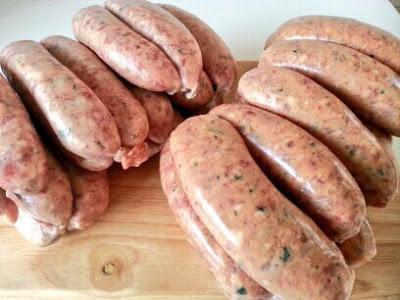
The word "sausage" comes from the Latin, "salsicius", prepared by salting, which in turn comes from Salsus, meaning "salted."Sausages have been produced, eaten and enjoyed in Great Britain since Roman times. The Anglo-Saxons developed their own varieties and the Normans brought French ideas into the mix, including pure pork sausages, black puddings (made with blood) and the andouille, an entrail sausage known in England as chitterlings.
You will find sausages in just about every country in the world, each with their own spin on this meat, fresh, dried and everything in between. What is it that makes British sausage stand out from the rest? What is it about British sausage that makes it so great?
For one we have such a wide variety to choose from . . . Yorkshire, Oxford . . . Cambridge, Cumberland . . . Country Pork, and those are just the basics. We stuff them with leeks and cheeses, spring onions, caramelised onions, mustard, honey, etc. We enjoy them for breakfast and we enjoy them for lunch. We love them for teatime, or high tea, and dinner. We eat them in baguettes and rolled up in puff pastry. Here in the UK, we just love our sausages, full stop!
In days of old they would have been dried and salted, perhaps even smoked, for preservation. These days for the most part however, with the modern wonders of refrigeration, we tend to enjoy them fresh. You can find them in other countries, but I have heard again and again how much people miss British Sausages where they live and how they can't find them, so first up I am going to give you a recipe which you can use to make your own homemade Basic British Pork Sausages
Basic British Pork Sausage
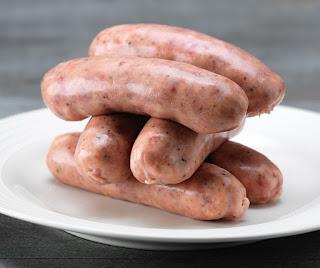 Yield: Makes about 16
Yield: Makes about 16Author: Marie RaynerYou should be able to buy the skins for these at a butchers or from an on line sausage making source. They will have been salted, which helps to preserve them, so do soak them in cold water first, preferably running water, running the water through the actual skins, and then dry with a cloth. Also cut them into 10 inch lengths, tying a knot in one end before filling. This will give you a bit of an excess but this will shrink during cooking and help to prevent them from bursting. You will need a meat grinder, or a good food processor.
ingredients:
- 2 pounds of boned and skinned shoulder of pork
- 4 pig's cheeks, trimmed
- 1/2 pound skinned pork back fat
- 1 brown onion, peeled and very finely chopped
- 1 1/2 TBS unsalted butter
- 1/4 tsp fresh thyme, chopped
- 1/4 tsp fresh sage, chopped
- 1 garlic clove, peeled and minced (optional)
- pinch ground mace
- 2 slices of stale good dry white bread, crusts removed and crumbled
- 1 medium free range egg, beaten lightly
- Worcestershire sauce
- salt and pepper
- about 4 meters (4 1/2 yards) sausage skins, well washed
- 25 - 50g of lard for frying (2 - 4 TBS)
instructions:
How to cook Basic British Pork Sausage
- Put all of the meats through the meat grinder on a medium mince. This should give you a medium coarse finish. If you prefer a smoother texture, you can pass the meat through the grinder several more times. Cover and place the minced meat into the refrigerator.
- Saute the onion and garlic in the butter along with the herbs and the mace over low heat, without browning for two to three minutes until quite soft. Let cool completely.
- Take the meat out of the refrigerator and mix completely with the cooked onion mixture. Stir in the bread crumbs and egg, adding a few drops of Worcestershire sauce and some seasoning. Take care not to over do the Worcestershire sauce. To check your flavours, take a small amount and fry it in a skillet, taste and then adjust the mixture as needed.
- To fill the sausage skins, you can use a sausage skin filler, or you can use a piping bag fitted with a 1/2 inch plain tube, filling the bag only half full for better control.
- Take the sausage skin and pull it back to the knot. Sit it over the end of the piping tube and squeeze. Once the sausage skin has been filled to the size of a standard sausage, remove the piping bag and push the meat further down the skin to give a good plump shake, pushing out any air left in the skin, then tie at the end. Repeat to fill all your sausage skins. Place onto a plate, cover and allow to rest in the refrigerator before proceeding to cook them.
- They are ready to be grilled or pan-fried. Pan frying is my preferred method of cooking. Melt the lard in a heavy bottomed skillet. Lay the sausage in the hot fat and fry gently, for 15 to 20 minutes, turning frequently, until they are golden brown and cooked thoroughly. Enjoy!
Note - you can replace the shoulder and cheeks with 2 1/2 pounds of pork belly, reducing the amount of pork fat by about 1/3 of a pound.
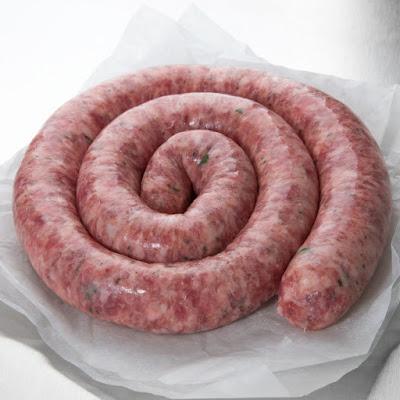
My absolute favorite of all the sausages has to be Cumberland sausage. It is said to be the meatiest of all the sausages and has a very distinctive peppery flavor that I really enjoy. At one time they used to be made from a special breed of pig, which unfortunately died out back in the late 50's/early 60's.
One of the most recognisable features of Cumberland sausage is that it is not twisted into links, but rather long length are shaped and rolled into a "Catherine Wheel" shape. Some of them can be quite long and in Cumbria you actually buy the by the length rather than the weight. We have had some really delicious ones when we have been staying up in Cumbria, that I have never been able to find anywhere else. Traditionally they are flavoured with a mix of cayenne pepper, white pepper, ground nutmeg and salt, a combination which I find extremely delicious. Its nice and peppery. If you want to have a try at making your own (and I hope that you do), it is best for you to just pipe the meat into two or three long sausages and then coil them into Cumberlands when done. You can then pan fry, grill or roast them as desired.
Yield: Makes 2 to 3 good sized Cumberlands
Author: Marie Rayner

Cumberland Sausage
Delicious. There is no other word for them. They are lovely kept in the coil shape and secured with a skewer and cooked whole, for cutting into sections at the table.ingredients:
- 1 pound lean pork shoulder, cut into rough dice
- a generous 1/2 pound pork belly, rind removed, cut into rough dice
- 1/3 pound pork back fat, cut into rough dice
- 100g soft fresh white bread crumbs (1 2/3 cup)
- 1 tsp chopped fresh thyme
- 1 tsp chopped fresh sage
- 1 tsp chopped fresh rosemary
- 2 - 3 yards sausage skins, soaked and washed in water, cut into 2 to 3 lengths
- butter, lard or cooking oil for frying
- 2 tsp salt
- 2 tsp ground white pepper
- pinch of freshly grated nutmeg
- pinch of cayenne pepper
instructions:
How to cook Cumberland Sausage
- Mince the meats to your choice using a meat grinder on a coarse disc for one turn, and the on a medium disc for another. Mix in the bread crumbs, herbs and seasonings.
- To fill the sausage skins, you can use a sausage skin filler, or you can use a piping bag fitted with a 1/2 inch plain tube, filling the bag only half full for better control.
- Tie a knot in one end of each length of skin.
- Take the sausage skin and pull it back to the knot. Sit it over the end of the piping tube and squeeze. Once the sausage skin has been filled to the size of a standard sausage, remove the piping bag and push the meat further down the skin to give a good plump shake, pushing out any air left in the skin, then tie at the end. Repeat to fill all your sausage skins. Shape into coils and place onto a plate, cover and allow to rest in the refrigerator for at least half an hour before proceeding to cook them.
- To bake, preheat the oven to 180*C/350*F/ gas mark 4. Brush with butter and place in a roasting tray. Roast for 25 to 30 minutes basting every so often with some butter.
- To pan fry, heat a skillet and add a drop of lard or cooking oil. Place the sausage into the pan and gently fry until golden on the underside (12 to 15 minutes), flip over and fry gently on the other side for 8 to 10 minutes. Serve immediately.
- To grill, brush with butter and place under a medium hot grill, cooking for 8 to 10 minutes per side.
- Serve hot.

TOAD IN THE HOLE - a British Comfort-food Favourite
A delightful and tasty comfort-food-recipe I discovered shortly after I arrived here was a lovely dish called Toad in the Hole. I had often heard about this British delicacy but had never had any idea of what it was let alone ever had the chance to try it. I soon learnt that it had nothing to do with holes, dirt, or even toads for that matter!
The origin of the name 'Toad-in-the-Hole' is quite vague. Most suggestions are that the dish's resemblance to a toad sticking its little head out of a hole provide the dish with its somewhat unusual name.
Yield: 2 - 3
Author: Marie Rayner

Toad in the Hole
To be sure, this is quite simply sausages baked in the oven with a delicious Yorkshire pudding batter baked around them, but there is an art to making a good one. Serve with plenty of fluffy mashed potatoes, onion gravy and a vegetable on the side.ingredients:
- 2 large free range Eggs
- 125g Plain Flour (1 cup, minus 2 TBS)
- 150ml Milk (2/3 cup)
- 150ml Cold Water (2/3 cup)
- Salt & Pepper
- 6 Good Quality Herby Sausages of your choosing (I like Cumberland myself)
- 2 tbsp Lard or Dripping or Cooking Oil
instructions:
How to cook Toad in the Hole
- On a low heat cook the Sausages in a frying pan on all sides until nicely browned and sticky. Do not prick the skins! Allow to cool.
- Crack open the eggs into a large measuring jug and beat well. Add the milk and water together, mixing it all together really well. Set aside.
- Sift the the flour into a large bowl and season with a sprinkling of salt & pepper. Make a well in the center. Gradually whisk in the liquid mixture, whisking until you have a stiff but smooth batter with no lumps. Allow to rest for half an hour.
- Pre-heat the oven to 205*C/425*F. Slip the lard or oil into a deep sided baking tin and place just this in the oven. Once it is quite hot and the fat is sizzling, quickly, but carefully, take it out and rest on the top of the hob. Pour in the Batter mixture. Then add the Sausages, parallel to each other, the length of the tin.
- Place back into the oven and bake for around half an hour until the batter is puffed up, golden brown and crispy. Serve cut into squares with fluffy mashed potatoes and a delicious gravy of your own choosing.
I have quite a few recipes using sausages on here and for convenience I am leaving you with a list of them here. Each are delicious in their own right and quite enjoyable! In each case I have provided you with a link to the recipe.

Sticky Sausages with Cream & Mustard Mash
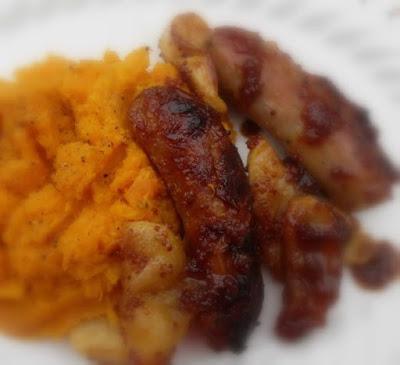
Sausage with Autumn Mash.

Orchard Pan Roast with Sausages.

Sage Roasted Bangers with Mash and Onion Gravy.

Sticky Bangers with Chive & Buttermilk Mash.

Sticky Sausage Tray Bake.

Dublin Coddle.
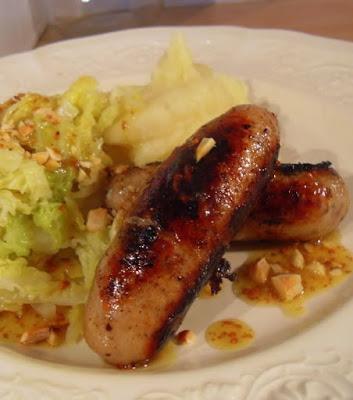
Herby Sausages with Parsnip Mash and Stir Fried Cabbage.

Cider and Honey Braised Sausages.

Sticky Maple Bangers with Irish Champ.
And there you have it, all I know about sausages. How to make your own British Sausages, and a few ideas on how to cook them once you have them made!
Up Tomorrow: Crispy Herbed Potato Rosettes.


